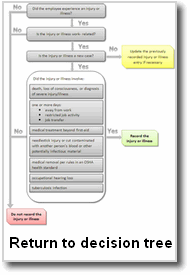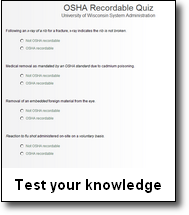Coordinators
OSHA definition of work-relatedness
You must consider an injury or illness to be work-related if an event or exposure in the work environment either caused or contributed to the resulting condition or significantly aggravated a pre-existing injury or illness. Work-relatedness is presumed for injuries and illnesses resulting from events or exposures occurring in the work environment, unless an exception specifically applies (table below).
Work environment — OSHA defines the work environment as “the establishment and other locations where one or more employees are working or are present as a condition of their employment. The work environment includes not only physical locations, but also the equipment or materials used by the employee during the course of his or her work.”
| EXCEPTIONS: You are not required to record injuries and illnesses if … | |
| (i) | At the time of the injury or illness, the employee was present in the work environment as a member of the general public rather than as an employee. |
| (ii) | The injury or illness involves signs or symptoms that surface at work but result solely from a non-work-related event or exposure that occurs outside the work environment. |
| (iii) | The injury or illness results solely from voluntary participation in a wellness program or in flu shot, exercise class, racquetball, or baseball. |
| (iv) | The injury or illness is solely the result of an employee eating, drinking, or preparing food or drink for personal consumption (whether bought on the employer’s premises or brought in). For example, if the employee is injured by choking on a sandwich while in the employer’s establishment, the case would not be considered work-related. Note: If the employee is made ill by ingesting food contaminated by workplace contaminants (such as lead), or gets food poisoning from food supplied by the employer, the case would be considered work-related. |
| (v) | The injury or illness is solely the result of an employee doing personal tasks (unrelated to their employment) at the establishment outside of the employee’s assigned working hours. |
| (vi) | The injury or illness is solely the result of personal grooming, self medication for a non-work-related condition, or is intentionally self-inflicted. |
| (vii) | The injury or illness is caused by a motor vehicle accident and occurs on a company parking lot or company access road while the employee is commuting to or from work. |
| (viii) | The illness is the common cold or flu (Note: contagious diseases such as tuberculosis, brucellosis, hepatitis A, or plague are considered work-related if the employee is infected at work). |
| (ix) | The illness is a mental illness. Mental illness will not be considered work-related unless the employee voluntarily provides the employer with an opinion from a physician or other licensed health care professional with appropriate training and experience (psychiatrist, psychologist, psychiatric nurse practitioner, etc.) stating that the employee has a mental illness that is work-related. |
What if it is not obvious whether the precipitating event or exposure occurred in the work environment or occurred away from work?
In these situations, you must evaluate the employee’s work duties and environment to decide whether or not one or more events or exposures in the work environment either caused or contributed to the resulting condition or significantly aggravated a pre-existing condition.
What is meant by “significantly aggravated?”
A preexisting injury or illness has been significantly aggravated, for purposes of OSHA injury and illness recordkeeping, when an event or exposure in the work environment results in any of the following:
- Death, provided that the preexisting injury or illness would likely not have resulted in death but for the occupational event or exposure.
- Loss of consciousness, provided that the preexisting injury or illness would likely not have resulted in loss of consciousness but for the occupational event or exposure.
- One or more days away from work, or days of restricted work, or days of job transfer that otherwise would not have occurred but for the occupational event or exposure.
- Medical treatment in a case where no medical treatment was needed for the injury or illness before the workplace event or exposure, or a change in medical treatment was necessitated by the workplace event or exposure.
For more information, see this section in the OSHA Recordkeeping Handbook.


